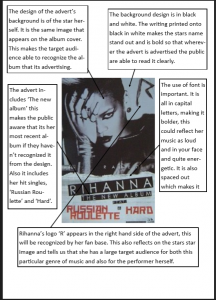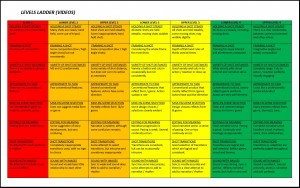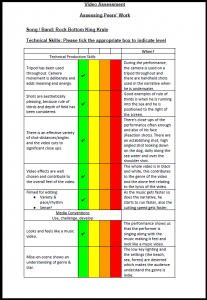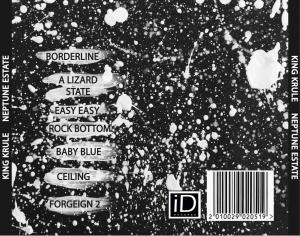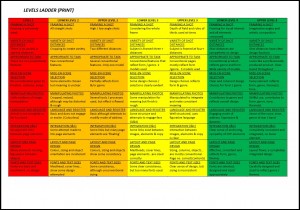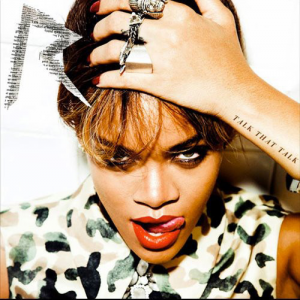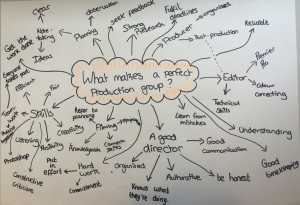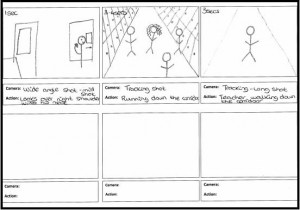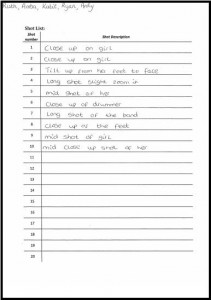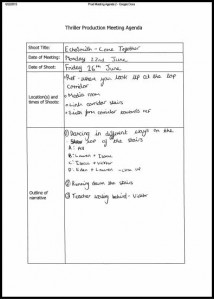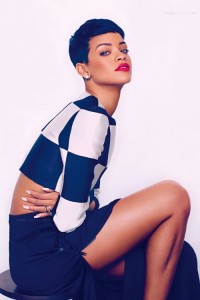Category: Research
Digi Pak Previous Students Work
Music Video
The video in which I studied in previous students work is ‘King Krule- Rock Bottom’. Out of the other previous students work, I think that this one was one of the best. I was most impressed by the mise-en-scene within the video and also the performance.
Here is a link of the video below:
I rated the video up against the level ladder and decided what level I would give it for its final draft. The level ladder is linked below:
After I decided what level I would give for what I recorded it into a video assessment document and made comments on examples where this is presented. Click below to see my assessment for ‘King Krule- Rock Bottom’ final draft’s assessment:
Overall, this music video was a high level 4 on the majority of elements however the syncing and isn’t very consistent throughout the video, sometimes it is clear that it is synced however for the majority it is not. This is where they would improve on, however overall it was a good music video.
Digi-Pak
I analysed previous students work for a digi-pak, for this I used the digi-pak cover for the music video above. Below is the Digi-pak for this music video:
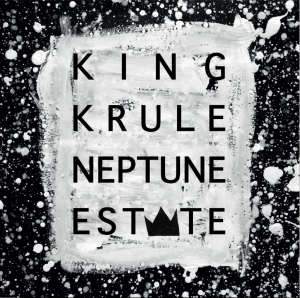
(The front cover)
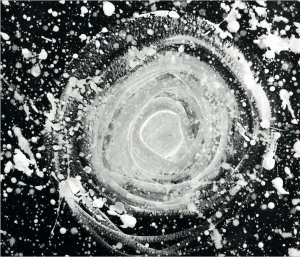
(The right inside cover)
After looking at this and analyzing it, I used the level ladder to record down what level I would have given this Digi-Pak.
Click below for the level ladder:
Using the level ladder I analysed the digi-pak from the previous students work and picked out the examples of what they used well to make it a good digi-pak. Click below to see what I analysed:
The digi-pak ranged from level 3/4. It included good relevance to the genre of music and I could easily tell the resemblance to the music video. It reflected the themes well. However, to improve they could of used a wider variety of shots to make the digi-pak more interesting.
What I learnt…
Overall, form doing this I learnt what to look for when creating my own music video and digi-pak. I learnt that the different conventions of a music video and digi-pak need to tie in with the genre of music and for this to be made apparent for the audience to recognize.
Digipak Conventions
For the music video of my choice, ‘We found Love’ by Rihanna and Calvin Harris I analysed the digipak. For this I used the front and back cover of the digipak case. I looked specifically into the different fonts used and what they mean and why they chose that one, also the background design, what is written on it.
The conventions of Digi-Paks are that they all have the Album name, for example for this digi-pak it is ‘Talk That Talk’, also the performers name for example ‘Rihanna’ in this case she has an R which shows she is known and has a fan base. Also on the back cover, there is a barcode and copyright which is also conventional of digi-paks.
‘Picture Perfect’ Production Group
In our production group we created a mind map of skills and qualities in which you need to make the perfect production group. The basic skills in which everyone needs are too be able to work in a team and consider everyone else’s opinions and to be able to agree on certain things. Also, good communication skills and listening skills in able to make sure everyone knows what they’re doing, where they need to be and what everyone’s opinions are.
Qualities that we need to have are to put in all of our efforts and come together as a team and get the work done. We need to be reliable and organized with our work and make sure the extra time is put in to be able to achieve the best we possibly can.
Other skills that we need between our Production group are cinematography skills in order to be able to use the camera equipment when it comes to filming and use of premier pro for the editing process. Then Photoshop skills when we come to designing and making our digi-pak’s.
The picture below is of our ‘Picture Perfect’ Production Group.
It also includes the skills and qualities that we need as a director, producer and editor.
Swede
For the swede our video is ‘Come Together by Echosmith’. Here is the link to the YouTube video below:
After knowing what section of the song we were going to film, we made a storyboard shot by shot. This included a rough drawing of the shot and the environment that we were going to shoot in and also the mise-en-scene. It also included the timing that the shot should last and the camera movement and framing. This helped us when coming to film because we had a visual to be able to quickly look at to find out what point we need to film and where we should be, as well as our shot list. Without both of these would of made filming a lot more difficult and more unorganized. Our storyboard is linked below:
We made a detailed shot list so that we knew exactly what shots we needed to film when it came to filming, making the process a lot faster and more organized. The shot list that we made was specifically for the performance from 3.52-4.15 during the song. The most common shots we found was close ups on the girl and long shots of the band. There are a lot of shots of the girl (the main singer) she appears to have a lot of camera time suggesting that she is important to the music video and performance and also it makes the audience aware that she is the lead singer.
As a class, we decided the most important shots for our performance that we should replicate for our shoot. The type of shots we’re going to use are linked below. The shots circled are the shots in which we are going to shoot and focus on, this will be the mid shot of the lead singer using handheld camera movement and also the mid shots of the two guitarists playing their musical instruments (2 shot).
We also made a Production Meeting Agenda which we recorded down who our actors were, the mise-en-scene they needed and who would provide it, where and when we were going to shoot the different shots, the outline of the narrative so that we knew the main stages of what we were shooting, who is filming and also costume and make-up. This gave us a specific guideline to what we were doing and who was doing what when it came to filming, keeping our group more well organized. We made a joint production meeting agenda for narrative and performance.
For our section of the swede we filmed the narrative and the performance. After the filming, we imported them into premier pro and edited our section together. The narrative and performance order matched the order of the music video. However, I didn’t use the same shot distances and camera movement for the performance as the video did, I made it my own and mixed up the shots in the video. The link embed below is of my section of the swede that I edited myself:
Evaluation Questions:
What lessons did you learn about planning and the use of Storyboards/Shot Lists and Production Meeting Agendas? Why are they important when out on shoot?
I learnt that the meaning of Storyboards, Shot Lists and Production Meeting Agendas are important because when we’re out shooting it makes us more organized and makes the process faster. It makes us know exactly what we need to shoot and what’s shots we need therefore we’re not going to film with no knowledge of what we’re doing. With the Production Meeting Agenda we were prepared with the mise-en-scene that we need and the actors costume and make-up.
What should the camera operator be doing whilst filming?
In preparation to film, the camera operator should make sure they know what they’re about to film first off. The camera should be in place and the framing should be correct for the shot that is about to be filmed. Before recording, the camera operator should make sure that the actors know what they are doing and make sure that they are comfortable. Also, to run through it before actually filming it. Also, the camera operator should make sure that the camera is actually filming rather then just taking a still image.
When we were filming, directing our actors was very important for them to know what they’re doing and what we wanted to get out of a particular shot was done by showing our actors what we wanted them to do and directing them and giving them advice on what they can improve. Also, we adjusted the camera to where we wanted it, this involved standing on a table to be able to reach up to the balcony where we were shooting. This gave us better framing for the shot and the camera was positioned better than just being on the table and not from a height. During filming, we started recording and then counted down for our actors to start performing still whilst recording so that we didn’t miss any of the shot and we could cut it out so its better to have more footage than not enough or missing out key scenes.
What lessons did you learn about directing people in front of the camera? What information do they need to know about their character / their performance style? How can the director get them to relax and have confidence in front of the camera in order to perform well?
From directing people I learnt that you need to be specific on physically show actors what to do as well as just showing them the music video so that they know what to do. Also, they need to know what their characters are like and what they are doing throughout the video so that they can get into role and this is the directors role to make sure of this.
The actors need to know what there characters are like, their appearance and the way they are presented on camera. For example, the way they walk, talk, move etc. In order to do this we showed our actors the video of our part of the music video and showed them how they needed to act and perform. Then we practiced together so that they felt more comfortable and weren’t the only one doing it and recorded after they knew exactly what they were doing and felt more comfortable.
In order to make the actors to perform well, the directors should join in with them and make them not feel silly doing it alone but also to make it fun and less stressful which will take the pressure off. Also to make sure that they know exactly what they’re doing so that they don’t have to worry about forgetting.
What lessons did you learn about filming the performance for your production?
For filming the performance I learnt that we should of got more close up shots of the lead singer because we didn’t have that many. However, we used a wheelchair in order to get smooth tracking and dolly shots. We filmed one big recording of the whole song in one just focusing on the camera movement which was tracking and dolly in and out. This turned out to be a success! This made the shots really good quality and really smooth. We filmed wide shots of the whole band and tracked in to focus on just the lead singer and guitarists. Then we went around the back and in between the band getting good close ups and mid shots of the drummer and guitarists. We then got close ups of their feet and faces whilst they were singing. We also got pans going from one performer to another. These didn’t work as well but they were unique and different.
I learnt that we had to experiment. We had to try different things to see if they would work or not, in which we did and we found certain things worked better than others like panning for example, a pan across the band worked well but a whip pan from performer to performer didn’t work as well but we had to try to figure out if it would or not. Also, we learnt that having the music louder made out performers more involved and excited about the performance, this got them into role and made them dance and perform better, making the filming easier because there was plenty of good shots for us to focus on getting.
To keep up the good performance, we encouraged our actors to keep going and making it known to them when they do something that is good. Also, we got them to repeat different moves that they did to make sure we got it on camera well.
What did you learn about editing and post-production?
During editing, I learnt that it is quite difficult to match the rhythm of the song with the video. However, putting the narrative in at the correct point was easier. I came across a problem, which was that we had some shots missing, this obviously effected the narrative so I had to film the parts that were missing and put them in. I struggled to not get the camera to shake whilst I was filming a tracking shot. I was walking backwards so I found it difficult. However, the editing was easier but choosing different sections from the performance was a struggle.
What did you discover about the use of conventional Mise-En-Scene for music videos?
I discovered whilst researching music videos and making the swede that the use of conventional mise-en-scene can identify the genre of music and it clear to the audience. The mise-en-scene varies from video to video, it depends of the genre of music to what is conventional.
Final Swede.
Click the video below to watch our final Swede from all of the sections that we have edited and filmed together as a class.
Star Image
I looked at star image and created a pinterest page of different photos of my star, Rihanna. It includes different photos of her products and advertising she has been involved in, photo shoots, news photos and magazine covers that she has been involved with.
Click on the link below to see my pinterest page:
What I learnt…
By doing this I learnt how my star is represented in all different ways. All of these different ways in which the star image is presented creates her metanarrative. Her metanarrative is her star image and how people perceive her.
Welcome To My Blog
Hello, Welcome to my A2 Media blog.
Please use the navigation tabs above to look at my Research, Planning, Production and Evaluation. Here is the brief that I will use:
A promotion package for the release of an album, to include a music promo video, together
with two of the following three options:
- a website homepage for the band;
- a cover for its release as part of a digipak (CD/DVD package);
- a magazine advertisement for the digipak (CD/DVD package).
Detailed Music Video Analysis
I did a detailed music video analysis of the song ‘We Found Love’ by Rihanna and Calvin Harris. The music video is attached below:
In this video I analysed its appeal and impact and doing this I got to fully understand the narrative in full detail, which is explained on the link below. Also the sense of subject matter and emotions during the video throughout. I also analysed the star image and the typical generic performance and within this the narrative content and relevant themes. In this video it is all narrative and has no performance however it relates to the lyrics and makes sense. I then analysed the cinematography and the effect this has on the audience and the star. Also the aesthetics, mise-en-scene and lighting and colour.
Click on the link below to my full detailed analysis of the music video:
Overall, analyzing the music video in more depth helped me to understand the relation between the stars image and whether or not the music video needs to relate to the lyrics and also if it is compulsory to have performance, which it is not.
Music Video Conventions
In this post, you’ll see that I looked at 6 different music videos and analysed them. I looked the performance and narrative, content, audience appeal and subject matters. Also the genres of what these music videos fall into.
Click on the link below to see my analysis:
Analyzing these music videos I learnt that not every video has a performance and not every music video has a narrative. Also that not all music videos relate to the song lyrics. The inter textual references in these videos don’t appear. However, this often happens when in music videos it has a reference to something else, for example a film. This happens in Demi Lovatos video ‘Let it go’ which features her performing and clips from the film Frozen (2014).
The conventions of a music video relate to the genre of music, in this case for example, Indie Rock appears to be all or mostly in black and white, which reflects the genre of music in which this is. So making it black and white are the music video conventions of this particular music genre, Indie Rock.
